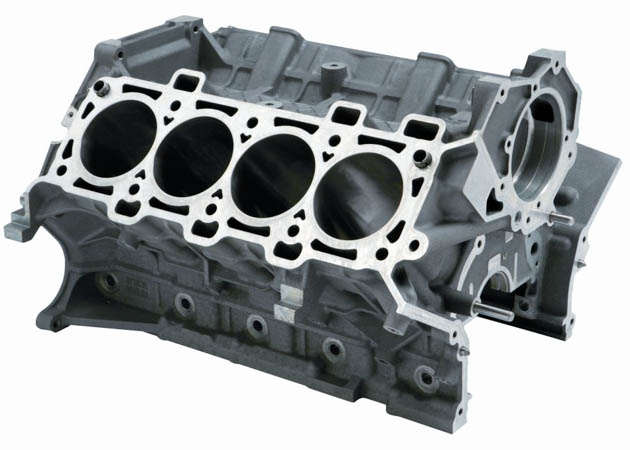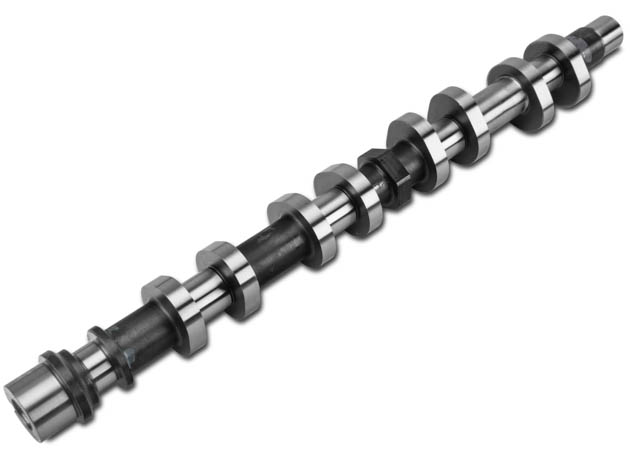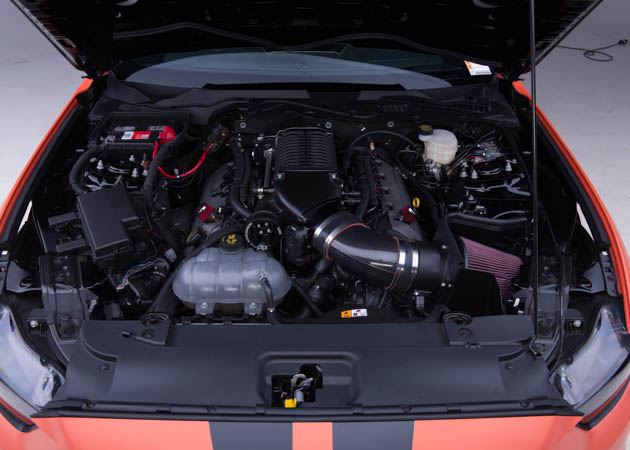How Much Boost Can a Stock Coyote 5.0 Handle
The Bits and Pieces
- The cake: all aluminum, with thinner walls than the previous iterations
- Forged steel crankshaft
- Hyperutectic pistons with oil jets underneath for cooling
- four valves per cylinder
- Powdered oil pump gear which doesn't always play dainty at high RPMs
The Block
Equally already mentioned, the Coyote 5.0L is an all aluminum motor. Lightweight and strong, the cake is cast from 319 aluminium with a bore spacing of 100mm, a deck height of 227mm and a deck thickness of 13mm. The cylinder walls characteristic thinner, pressed-in iron sleeves, resulting in a diameter diameter of 92.2mm, which is 2mm larger than the previous four.vi engine. This extra 2mm was achieved by the in a higher place mentioned thinner cylinder sleeves. Notwithstanding, despite the cylinder linings being thinner, overall integrity was non compromised. Released as a naturally aspirated engine, Ford originally did design the new Coyote engine to be capable of accommodating a ability adder downward the road. Therefore, at 435 horsepower, the Coyote is nowhere about tapped out. The aftermarket has shown that these blocks remain in one piece even when harboring double the stock output.

Rotating Assembly
2011 5.0L engines rolled out of the Essex assembly plant with a forged steel, counterweighted crankshaft. The connecting rods, of the I-beam diverseness, are powdered-metal. Connected at the top end are hypereutectic pistons. Ford engineers have specified the weakest link in the Coyote engine to be the powdered-metal rods, and have since corrected the design in the S550. S550 Mustangs harbor Forged rods rather than powdered metal.
Near people groan when they hear about hypereutectic pistons being used, and information technology's true. They are not as robust equally their forged counterparts. However, Ford integrated oil cooling jets that spray the bottom of the piston at all times, helping proceed their temperature downwards which increases their overall durability. The stock hypereutectic pistons are very comfy at 435 horsepower, and definitely have more room to grow. On the other paw, those wishing to slap on a ability adder and push some serious boost through the motor will definitely want to change the stock pistons with a forged variety. In stock trim, information technology seems the realistic limit of the stock rotating assembly is around 600 horsepower to the wheels (depending on bulldoze railroad train loss, tin can equate to 750-800 horsepower at the crank). Nonetheless, that is mighty impressive!

Cylinder Heads
The cylinder heads on the Coyote are game changers; there is no doubt about that. The aluminum, 4-valve per cylinder heads are a major reason the Coyote engine is able to produce over 400 horsepower from a displacement of just 5.0L. These new heads are highly efficient and have excellent flow. Actual flow numbers are hard to come by, but information technology is highly speculated that they flow effectually 300 CFM out of the manufactory. Equally a production piece, this is an astonishing number! Dissimilar the previous E7TE cylinder head of the Foxbody generation, the S550 are non a restriction.

Oil Pump Gear
Ah, the oil pump gear – a blast from the past! Considerable concern has risen regarding the stock powdered-metal oil pump gear that comes equipped with a stock Coyote engine. Similar previous modular Mustangs, at higher RPM and power levels (particularly with a boosted Mustang), oil pump gears are declining. High ability loads at high RPM (usually from a supercharged or turbocharged engine) can cause the crankshaft harmonics to change and be passed on to the oil gear pump. Later, the stock powdered gear is speedily fatigued and ends up shattering, leaving a big mess inside the engine. For Mustangs that spend a lot of time at the rail and in the upper RPM's, changing the oil pump gear is considered a wise choice. Unfortunately, it is a pretty big job!

Pop Power Property Mods Shop All S550 Mustang Engine Mods
The Real Globe Limit & Your Drivetrain
Unfortunately, it is very hard to define a be-all-terminate-all limit for the new Coyote engine. Like the old 5.0L pushrod V8, numbers vary all over the place. However, the general consensus is the new Coyote can live comfortable and reliably at 750 crank horsepower. Getting this kind of ability out of the S550 will of course necessitate the addition of a power adder, but every bit long as the car is configured and tuned properly, the stock pieces should be fine up until then. Every bit mentioned, the major weak point in the S550 as it stands the hypereutectic pistons.
Equally far as the balance of the drivetrain is concerned, a general rule of thumb is that of the engine itself. It is always a good thought to add a driveshaft prophylactic loop for any higher horsepower application. The higher stress levels (hard launches, bicycle hop, etc) will cause failure faster, regardless of horsepower levels.

How Much Power Can the S550 Transmission Handle?
How much power tin the MT-82 accept? The transmission is rated to handle 383 ft/lbs of torque in stock form. Though, with all the power of the mighty Mustang, Ford has beefed up the trouble kid transmission for the S550. The problems Ford has addressed deal with bad hardware and shift response, not necessarily how much ability tin be run through information technology. If yous plan on tracking your car frequently yous will want to accost the internals or move to a beefier transmission. The Mustang is a passenger car built for daily driving afterward all. If the limit is pushed and the manual if left be, cleaved input shafts are a common effect of chirapsia on this particular transmission.
Fitment includes: 2015, 2016, 2017, 2018, 2019, GT
Source: https://www.americanmuscle.com/s550-coyote-power-limits.html